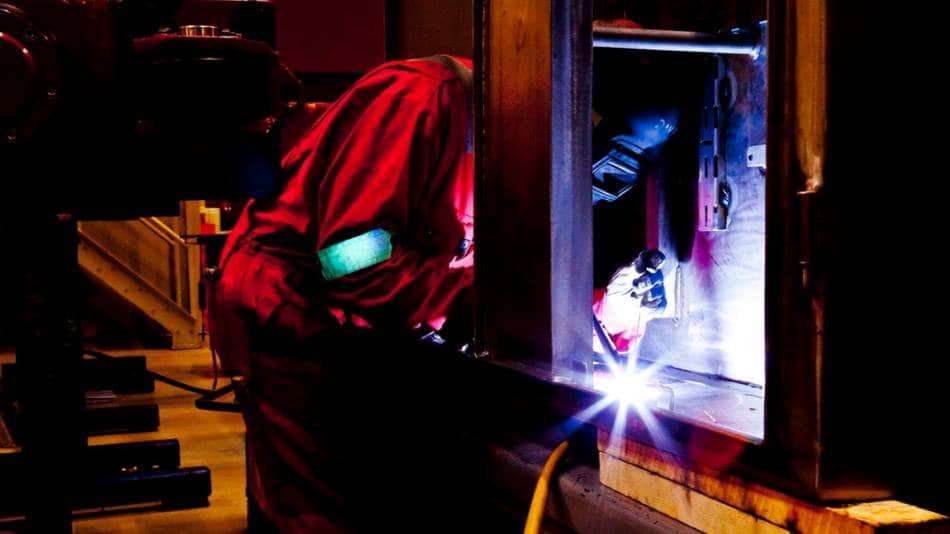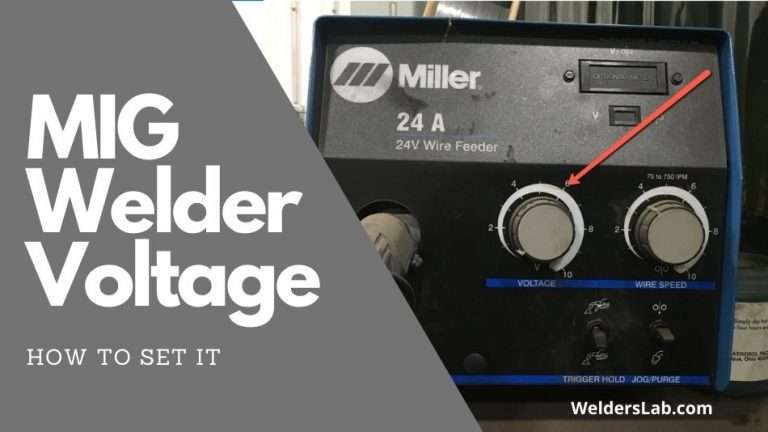Why Is My MIG Welder Popping and How To Fix It

One of the very first times I turned my MIG welder on and tried making my first weld I noticed it was making the odd popping sound with my weld and I wondered what I could do to fix this issue.
Why is my MIG welder popping? MIG welders often create a popping noise if the wire speed is either to fast or to slow and not set correctly. Often times you’ll have to adjust the wire speed until finding the optimal setting that will give a consistent buzzing sound that you are looking for.
Even though wire speed is the main culprit for the reason why your MIG welder could be popping and producing an inconsistent weld there are actually several major factors that will help you avoid this altogether. In this
Why Do MIG Welders Pop
The main reason your MIG welder will pop is that your wire speed is either to slow or to fast. To test this simply hold your welder up to a piece of metal you are trying to weld.
Hold the trigger and if the welder makes a loud popping noise and tries to push the gun back it means the wire speed is not set right and needs to be adjusted.
When it comes down to it wire speed is probably the main factor as to why your welder is popping but there can be multiple causes that are making your welder pop.
#1 Material Thickness
First off, the thickness of your material matters. If your welding
Whereas if you are welding a thicker piece of metal you’re going to run at a slower IPM. More importantly, the slower you go deep you will penetrate into the metal.
Go to slow though and your welder will pop, to fast and your welder will pop.
#2 Wire Size
The size of your wire also factors into whether or not your welder will pop. Different size wires will need to run and different speeds to avoid popping.
For example, a 0.23 welding wire may run great at 300 inches per minute (IPM) while a 0.35 wire may run great at 150 IPM.
Side Note: Be sure to check your owners manual for the optimal settings before you start welding.
# 3 Wire Type
The type of wire you use also plays a big factor in the speed you will set your welder at.
For example, if you are using flux core wire it will run at totally different speeds than solid core wire. If are welding aluminum then it will run differently than stainless steel.
The key here is to know what you are welding and how deep you plan to penetrate.
#4 Amperage
Next to wire-speed amperage is probably the second most important factor in avoiding popping with your welder. Not having this set correctly set may be making your wire burn to hot or too cold.
To figure out the amperage you should be running take the thickness of the metal you are welding and multiply it by 1000.
For example, if you’re welding 1/4″ mild steel you would multiply it by its decimal
So now that you know the factors that cause a MIG welder to pop you might be wonder how do you stop it from actually popping.
How to Stop a MIG Welder From Popping
Here are a few things you can do to stop your welder from popping.
#1 Your Wire Speed Is To Fast
The first thing to obviously look at is your wire speed itself. Some people like to think that a faster wire speed makes them look better and get more done.
To start simply adjust your wire speed up or down till you get a constant buzzing sound as you weld. Once you get this you’ll likely have solved the problem but if this didn’t follow the tips below.
#2 Check Your Tip
Next, you’ll want to check the tip in your welding gun. Often times the tip can get plugged with splatter, dirt or even burn back into the tip causing the welding wire to stick.
If this is the case you’ll want to remove the old tip and put a new tip on. This is what I do a lot of times if I’m using my welder constantly.
#3 Check Your Wire Size
Next, check the wire size and make sure you have the right wire size in your welder. This is a common mistake that can happen real easily.
This recently happened to me when our supplier dropped off some welding wire and it was a 0.35 wire and not a 0.45 wire which is what we regularly run.
It this case the welding wire was running slow and since we are set up for 0.45 and cause our welders to pop and produce terrible looking welds.
#4 Is Your Wire Rusty
Another thing to look for is if your wire is rusty. Often times if your wire sits out in the open in a shop or garage it will start to rust especially if their is a lot of moisture.
Running rusty wire can cause your wire to stick as it passes through your welding gun and give it a jerking motion which will cause it to pop.
To solve this issue either replace the wire with a fresh role if its very rusty or put a shop rag on the wire and clamp a close pin on it to help remove the dirt and rust as it passes through the welder.
Also once you’re done welding make sure you put a towel or blanket over the top of the wire to protect it from rusting or collecting dust.
#5 Is Your Amperage Set Correctly
Next, make sure your amperage is set correctly as I mentioned before. Just remember the thicker your metal the higher your amperage should be.
I will share more on settings here in a bit.
#6 Check Your Liner
Finally, my last tip is to check your liner in the lead of your welder. Your lead is the cable that comes out of your welder and goes to your weld gun.
Inside your weld gun is a liner that protects the wire as it passes through the rollers, lead, and finally through your weld gun.
From time to time the liner will get plugged up with dirt mainly because of the dirt on your welding wire. Like most welding shops they aren’t the cleanest places and tend to collect a lot of dirt.
If enough dirt gets into the liner it may cause it to plug up and even cause the welder to pop. To solve this issue just replace the liner.
Wire Speed – How to Set It
Now that you have an idea of what could be the problem I want to share what you should set your welder’s wire speed and amperage at depending on the type of metal you are welding.
By the way, these settings are meant for welding mild steel.
- 0.23 Wire – Welding between 22 and 18 gauge material should be running between 30 and 90 amps and a wire-speed between 100 to 400 inches per minute.
- 0.30 Wire – Welding between 22 gauge and 1/8 inch material should be running between 40 and 145 amps and a wire-speed between 90 and 340 inches per minute.
- 0.35 Wire – Welding between 18 gauge and 1/4 inch material should be running between 50 and 180 amps and a wire-speed between 80 and 380 inches per minute.
- 0.45 Wire – Welding between 16 gauge and 3/8 inch material should be running between 75 and 250 amps and a wire-speed between 75 to 200 inches per minute.
Related Questions
#1 What causes excessive spatter in MIG welding? Excessive splatter will happen if your voltage is to low or your amperage is too high. You will typically have to adjust these settings till the splatter decreases.
#2 Why is my welder sputtering? This will happen when your welder’s amperage and voltage are set to high causing the welder to reduce the current. This will cause the welder to sputter and the result will be a terrible looking weld.
#3 How can spatter be kept from sticking to a nozzle? When you weld for long periods of time spatter will build up on the inside of your nozzle. To stop this from happening, remove the excess splatter and dip your nozzle in some tip grease to help prevent more spatter from sticking to the inside of the nozzle.
When it comes down to it knowing how to set your welder will help you avoid popping while you weld.
Are you having issues with your MIG welder popping?






